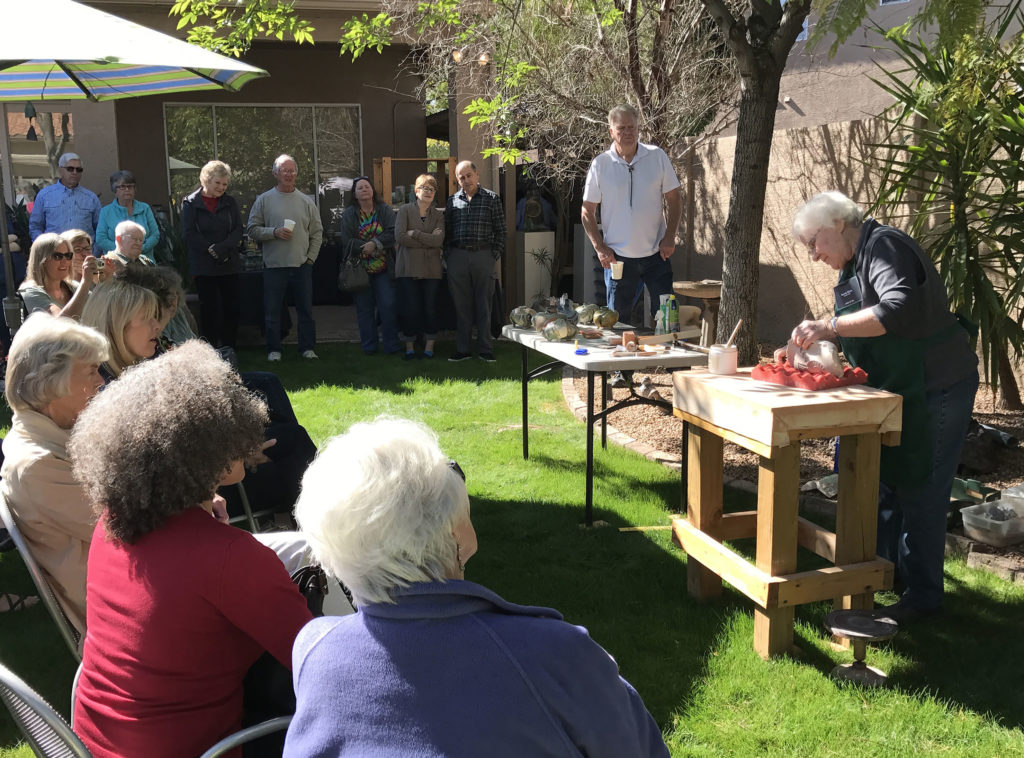
By Janie Magruder
If you’ve ever viewed a beautifully-glazed, exquisitely-textured ceramic mug or vase and wondered, “How’d they do that?,” your chance to find out is coming.
And for Wrangler News readers, one such occasion is in our own neighborhood. The 19th annual ASU Art Museum’s Ceramic Studio Tour will be 10 a.m. to 5 p.m. Feb. 22-23 at 12 sites, including Sandy Blain’s Warner Ranch home, around Tempe, Phoenix and Scottsdale. The event is free and open to the public.
Presented by the museum’s Ceramics Research Center, the self-guided tour is a rare opportunity to see the working and living spaces of professional artists and watch demonstrations of wheel-throwing, hand-building and glazing techniques. A wide range of functional and sculptural artwork also will be exhibited and for sale.
“It’s intriguing to see at each of the tour’s stops five different artists, all dedicated teachers, demonstrating different clay forming and surface finishing techniques,” said Blain, a tour host for the past 14 years.
Blain will be joined at her home by Sandra Luehrsen, Mesa Community College; Jane Kelsey-Mapel, Glendale Community College; Esmeralda DeLaney (GCC); and Michael Ceschiat (Chandler-Gilbert Community College).
Demonstrations of sculptural coil building, fired ceramics and mixed-media surfaces, figurative sculptures and more are scheduled.
As a girl, Blain worked in her grandmother’s flower shop in Chicago, planting and flower arranging. She was especially interested in the relationship of botanicals to their containers.
Blain became a high school art teacher, later joining the faculty of the University of Tennessee, Knoxville, where she taught until moving to Tempe in 2004. In addition to presenting workshops around the country, she also is an adjunct faculty member at Mesa Arts Center.
Inside her clean, bright studio—formerly the garage—Blain spends hours mixing chemicals and glazes, molding chunks of clay and imprinting the rolled-out sheets with found objects, from corrugated cardboard and odd scrap wood to spiky metal gears and bumpy rubber mats.
The pieces will dry there before being moved into her backyard electric kiln and fired to 1,900 degrees. Layers of glazes are applied by an industrial sprayer in ways that capture interest and invite reflection. This space is also where Blain uses her potter’s wheels.
Her studio walls are lined with dozens of functional vessels—flower vases with multiple spouts, three-dimensional songbirds on mugs (microwave- safe), covered butter plates (dishwasher-safe) and artsy cream pitchers.
Blain’s works have been featured in numerous books and in juried and invitational exhibitions regionally, nationally and internationally. A recent series of unconventional cylinders, which she calls Cityscapes, reveal levels, balconies, overhangs, cantilevers and windowed walls.
The heavily textured vessels, between 10 and 22 inches tall, are mostly concrete-hued, but each has a unique marking of bright color. They evoke thoughts of a row house with individual residences each distinguished by a colored front door.
Perhaps one will find a way into your home later this month.
Visit asuartmuseum.asu.edu/studiotour for more information including Blain’s address, a map and demonstration schedule.

